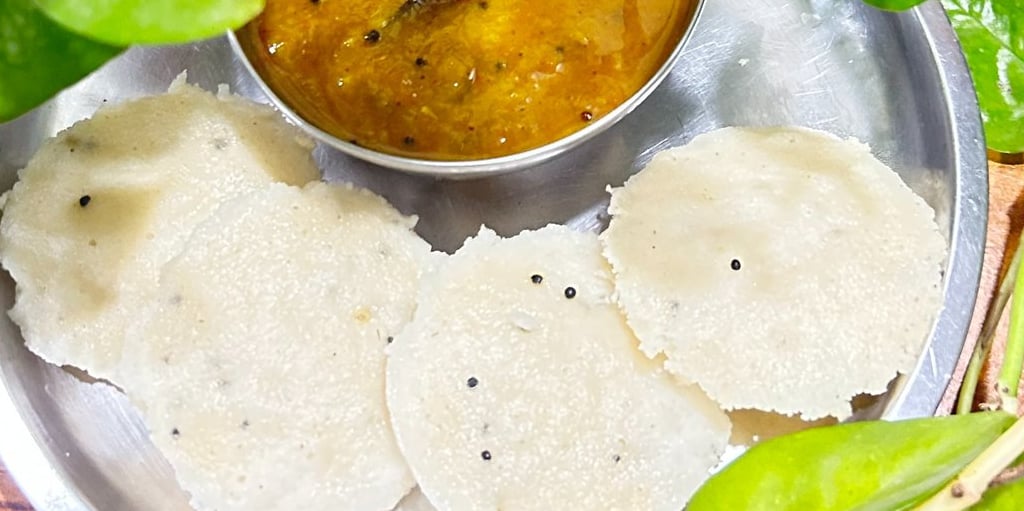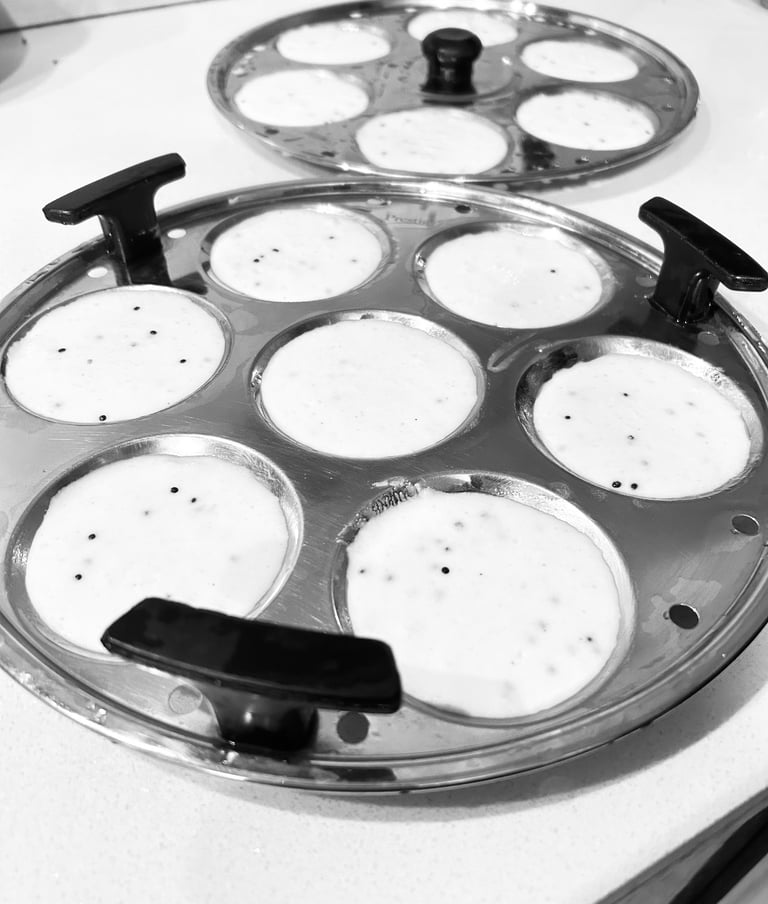Idli: A Nutritional Powerhouse and Cultural Delight
1/5/20254 min read


Nutritional Benefits of Idli
Steamed to perfection,served with heritage
'Idli', a 'beloved' traditional South Indian dish, offers a rich array of nutritional benefits, making it a popular choice in various diets. Primarily composed of fermented rice and urad dal (black gram), idli is an excellent source of essential nutrients. The combination of these ingredients results in a dish that is high in protein while remaining low in calories. This makes idli particularly appealing for individuals seeking to manage their weight without compromising on their nutrient intake.
The fermentation process involved in preparing idli not only enhances its flavor but also significantly boosts its nutritional profile. Fermentation increases the bioavailability of nutrients, allowing for better absorption by the body. Furthermore, it fosters the growth of beneficial probiotics, which play a vital role in maintaining gut health. These probiotics aid digestion, promote a balanced gut microbiome, and can even enhance the immune system.
In terms of macronutrients, idli stands out due to its high carbohydrate content, providing a quick source of energy. This characteristic makes it an ideal meal for breakfast, helping individuals to kickstart their day with sustained energy levels. Additionally, the presence of dietary fiber in idli contributes to a feeling of fullness, supporting healthy digestion and potentially aiding in weight management efforts.
Moreover, idli is versatile and can be incorporated into various dietary plans, including those for individuals with diabetes. Its low glycemic index means that it does not cause significant spikes in blood sugar levels when consumed. Thus, idli serves not only as a delicious cultural staple but also as a nutritionally balanced choice for many health-conscious individuals.
Cultural Significance of South Indian Delicacies
Idli, a steamed rice cake, exemplifies the rich culinary heritage of South India, serving not only as a staple food but also as a significant cultural symbol. Historically, idli has evolved from its ancient roots, where early mentions can be traced back to texts dating as far as the 10th century. Its preparation has transformed over time, reflecting the region's agrarian practices and availability of ingredients. As a traditional dish, idli occupies a central position in both everyday meals and festive occasions, illustrating its importance in communal gatherings.
The idli is typically served with an array of accompaniments, such as sambar and coconut chutney, enhancing its nutritional profile. The fermentation process involved in its preparation not only improves digestibility but also enriches the flavor, offering a unique culinary experience. Moreover, this method of preparation fosters a sense of community, as families often participate in the making of idli, bonding over shared culinary practices. In various South Indian households, weekends are often reserved for making large batches of idli, which are then enjoyed together as a family.
Regional variations further highlight the nutritional diversity of idli. For instance, in some areas, variations incorporating different lentils and spices augment the health benefits of this dish. These adaptations showcase the ingenuity of local populations in utilizing available resources while maintaining a strong connection to their cultural identity. Additionally, traditional diets that include idli and similar foods contribute to the nutritional health of communities, promoting a balanced intake of carbohydrates and proteins essential for well-being.
The significance of idli extends beyond mere sustenance; it serves as a reminder of the shared cultural heritage of South India. This culinary delight continues to play a vital role in shaping the social fabric, fostering community bonds, and celebrating the region's historical richness.
Health Benefits of Idli for Modern Dietary Needs
Idli, a traditional South Indian dish, is not only a culinary delight but also a significant contributor to modern dietary requirements. One of the primary health benefits of consuming idli lies in its low glycemic index, which makes it an excellent choice for individuals aiming to manage their blood sugar levels. The fermentation process involved in making idli enhances its nutritional profile and promotes better digestibility, allowing for slower glucose absorption, thereby aiding in blood sugar control and making it a diabetes-friendly option.
Moreover, the fermentation of idli batter enriches it with probiotics, which play a vital role in promoting gut health. The beneficial bacteria produced during fermentation can help improve digestion, reduce bloating, and enhance nutrient absorption. This aspect aligns well with the growing emphasis on gut health in modern dietary choices. Idli's light and fluffy texture makes it an easily digestible food, suitable for individuals with sensitive stomachs or those recovering from illness.
Idli is also an essential component of vegetarian and vegan diets, as it provides a valuable source of protein without the need for animal products. Made primarily from rice and lentils, idli delivers essential amino acids that contribute to muscle maintenance and overall health. With the increasing popularity of plant-based diets, idli serves as a nutritious alternative that can easily fit into various dietary patterns while being both satisfying and healthy.
Incorporating traditional foods like idli into contemporary nutrition is crucial for balanced health. Not only does it offer a range of health benefits, but it also connects individuals to cultural roots and culinary heritage. As modern diets evolve, embracing nutritious traditional foods like idli can play a significant role in maintaining overall well-being.
Simple Idli Recipe to Try at Home
Making idli at home is a straightforward process that requires minimal ingredients. Below is a simple recipe that will guide you through creating fluffy and delicious idlis, perfect for breakfast or as a light meal.
Ingredients:
1 cup parboiled rice
1 cup urad dal (split black gram)
1/2 teaspoon fenugreek seeds
Salt, to taste
Water, as needed
Preparation Steps:
Begin by soaking the parboiled rice, urad dal, and fenugreek seeds separately in water for at least 6 hours or overnight.
After the soaking period, drain the water and blend the urad dal and fenugreek seeds together until smooth, adding a little water if necessary.
Next, blend the soaked rice to a coarse paste consistency, combining it with the dal mixture. Add water as needed for a batter-like texture.
Mix both blends thoroughly and add salt. Transfer the batter into a large container, allowing room for expansion as it ferments.
Cover the container and let the batter ferment in a warm place for approximately 8 to 12 hours, or until it has doubled in size and appears bubbly.
Once fermented, stir the batter gently to mix. Grease idli molds with oil and pour the batter into each compartment.
Steam the idlis in a steamer for about 10 to 15 minutes. They should be firm and cooked through.
Tips for Perfecting Fermentation: Optimal fermentation is key for soft idlis. If your kitchen is cool, consider placing the batter in an oven with the light on or wrapping the container in a warm towel.


Contacts
Socials
Subscribe to our newsletter
support@otgscience.in
Copyright © 2024 otgscience.in
.
